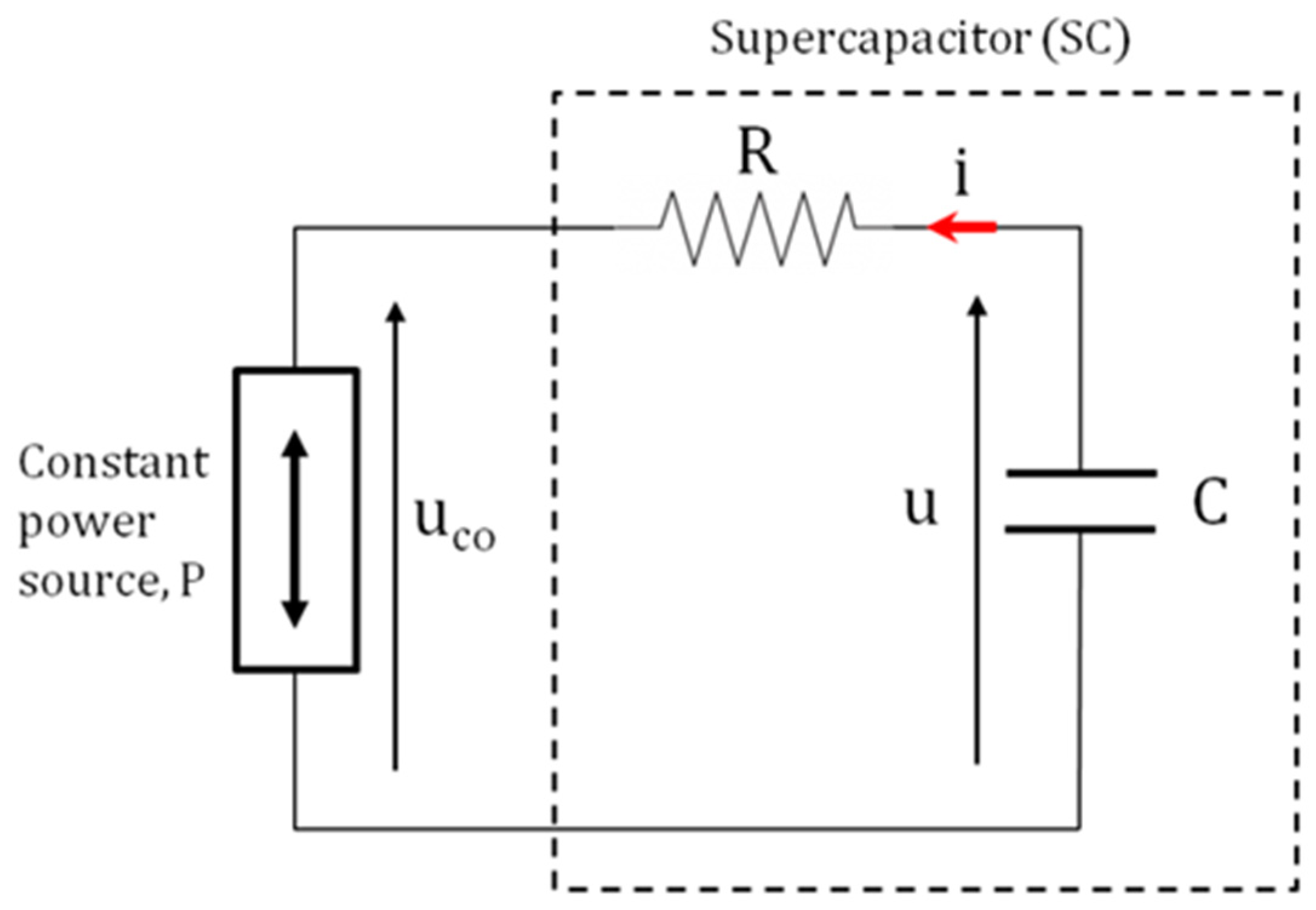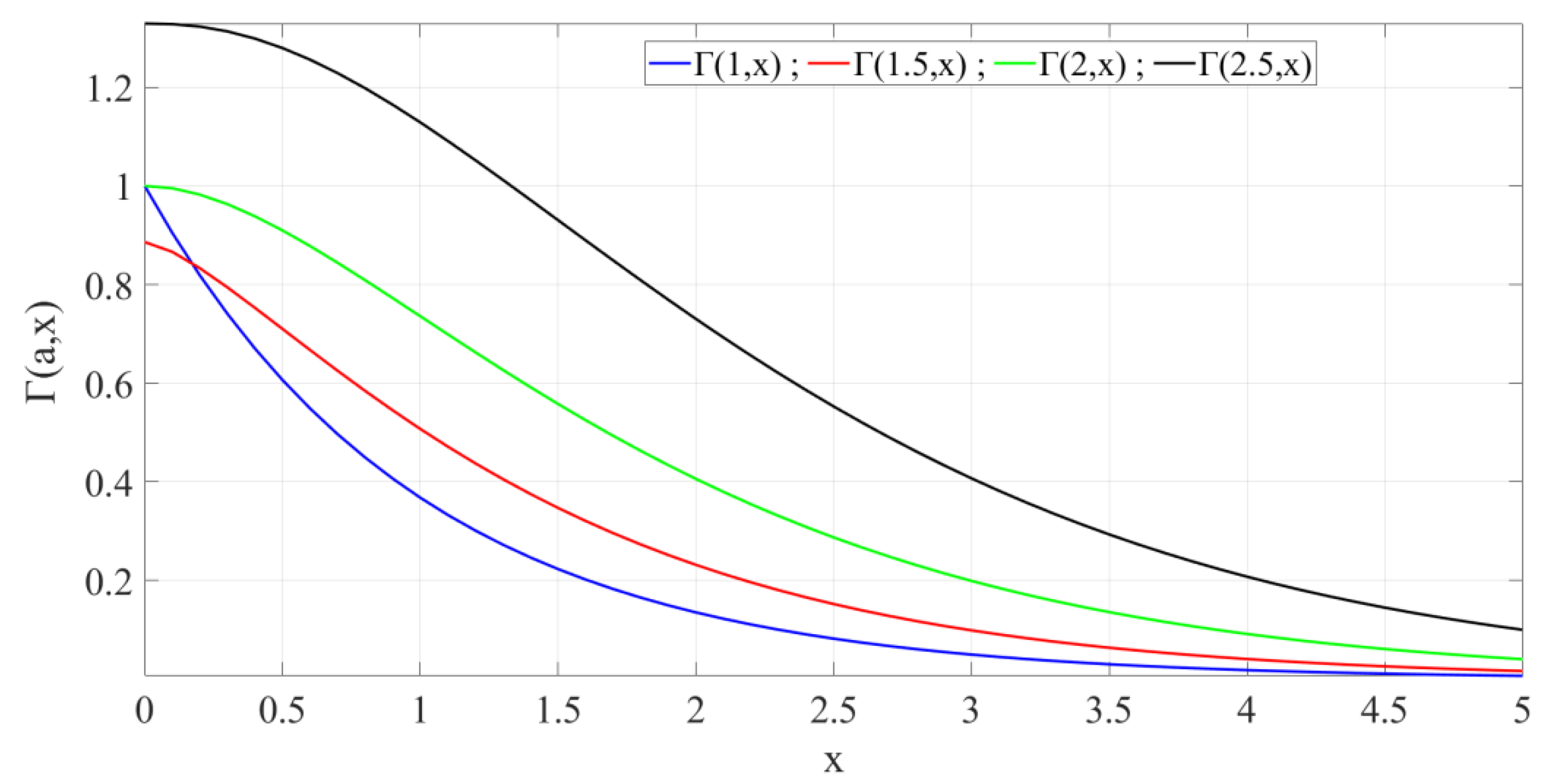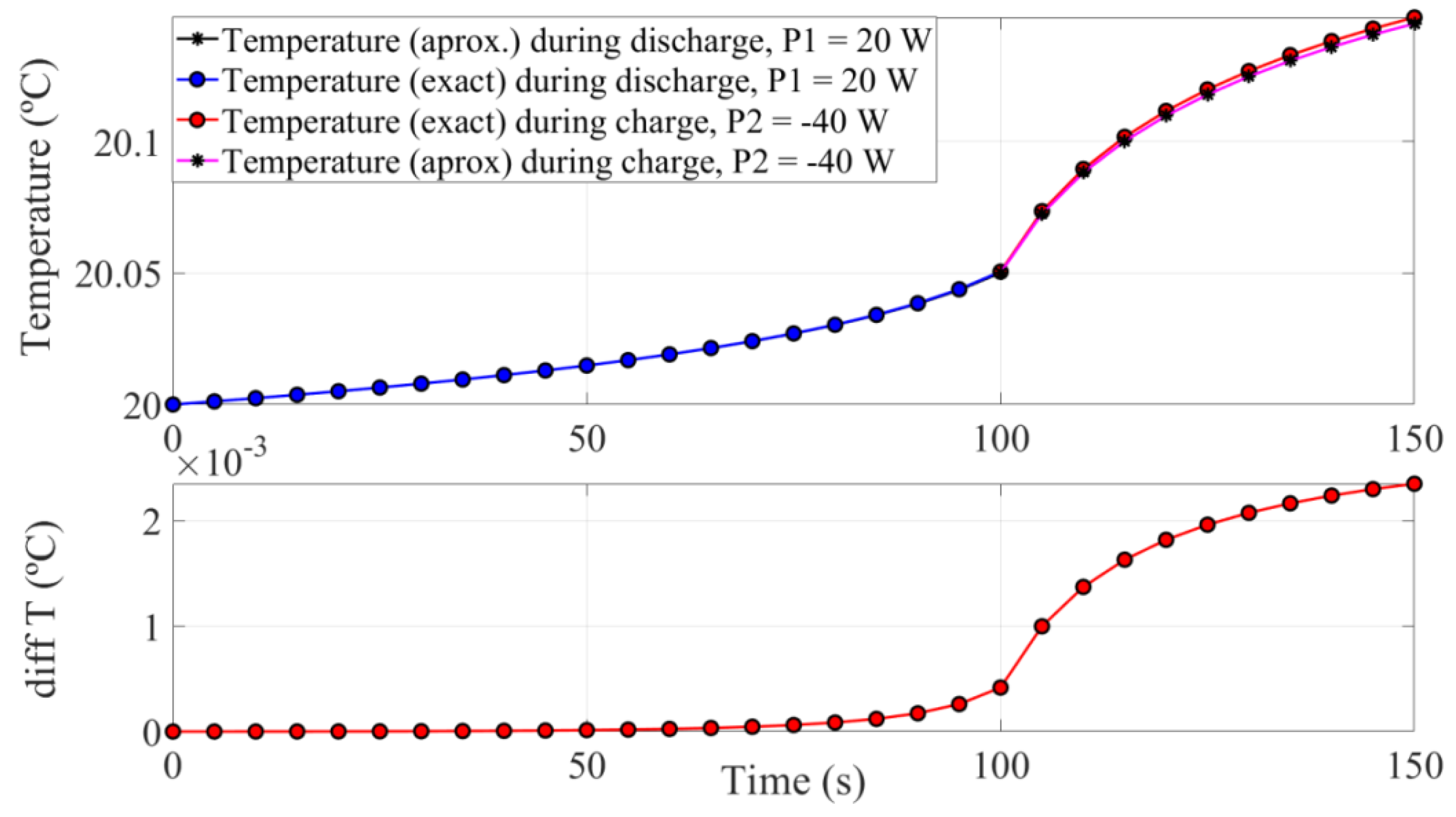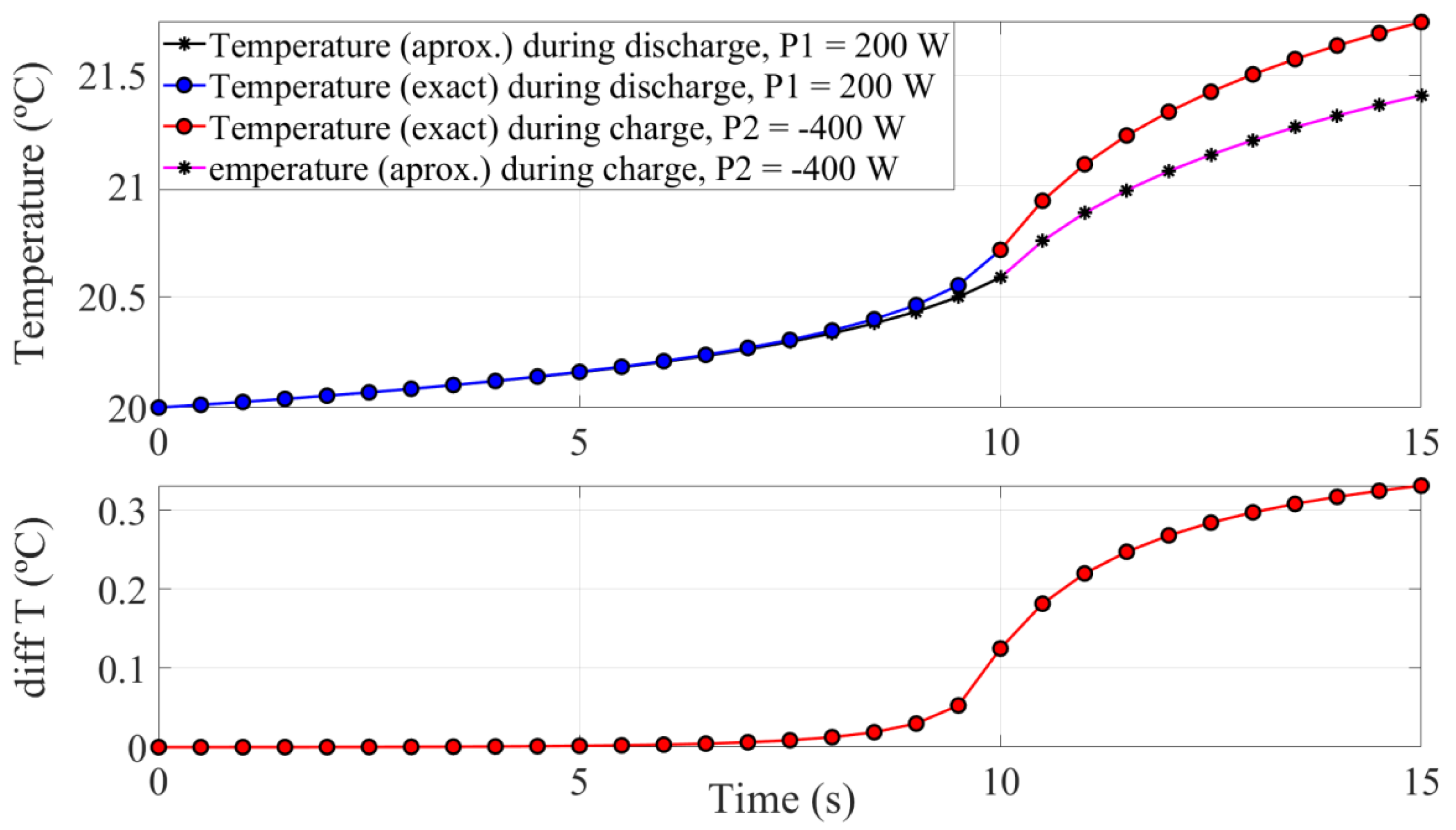Supercapacitors in Constant-Power Applications: Mathematical Analysis for the Calculation of Temperature
Abstract
:1. Introduction
2. Materials and Methods
2.1. Electrical Analysis of an SC Cell Operating at Constant Power
2.2. Incomplete Gamma Function
2.3. Thermal Analysis of SCs Operating at Constant Power Based on the Incomplete Gamma Function
3. Discussion
3.1. Charge and Discharge at Low Power
3.2. Charge and Discharge at High Power
3.3. Summary and Practical Application
- By means of the values of R, C, U0, and P, the function g(t), described in the Equation (2), must be defined.
- Once g(t) is obtained, the function g1(t) must be calculated by means of Equation (1).
- By using the values of R, C, RTH, and CTH, the constant “a” will be defined according to Equation (16).
- The initial thermal jump, θ0, will be calculated as the difference between the initial temperature of the cell, T0, and the ambient temperature, Tamb; θ0 = T0 − Tamb.
- Once θ0, RTH, P, a, and g1(0) (g1(t) for t = 0) are known, the value of the constants kθ1 and kθ2, according to the Equations (29) and (30), will be calculated. The function f(a, g1(0), g1) will be defined as well, as stated in Equation (28), g1(t) being the function previously defined in the point 2 of this summary.
- The evolution of the temperature of the cell vs. time will be then the following:
4. Conclusions
Author Contributions
Funding
Institutional Review Board Statement
Informed Consent Statement
Data Availability Statement
Conflicts of Interest
Glossary
| A, a, b, , , , | Constants |
| Capacitance | |
| Thermal capacitance | |
| ratio (dimensionless) | |
| initial ratio ( calculated at t = 0 s) | |
| i | current of the cell |
| P | Power of charge/discharge |
| dissipated power in R | |
| Equivalent Series Resistor | |
| Thermal resistance | |
| t | time |
| Ambient temperature (considered constant) | |
| Temperature of the SC cell | |
| u | Internal voltage of the cell |
| initial internal voltage | |
| External voltage of the cell | |
| Initial external voltage of the cell | |
| Temperature different between and | |
| Initial temperature different between and |
References
- Peng, H.; Wang, J.; Shen, W.; Shi, D.; Huang, Y. Compound control for energy management of the hybrid ultracapacitor-battery electric drive systems. Energy 2019, 175, 309–319. [Google Scholar] [CrossRef]
- Joshi, M.C.; Samanta, S. Improved Energy Management Algorithm With Time-Share-Based Ultracapacitor Charging/Discharging for Hybrid Energy Storage System. IEEE Trans. Ind. Electron. 2019, 66, 6032–6043. [Google Scholar] [CrossRef]
- Bolborici, V.; Dawson, F.P.; Lian, K.K. Hybrid Energy Storage Systems: Connecting Batteries in Parallel with Ultracapacitors for Higher Power Density. IEEE Ind. Appl. Mag. 2014, 20, 31–40. [Google Scholar] [CrossRef]
- Zhao, C.; Yin, H.; Ma, C. Equivalent Series Resistance-based Real-time Control of Battery-Ultracapacitor Hybrid Energy Storage Systems. IEEE Trans. Ind. Electron. 2020, 67, 1999–2008. [Google Scholar] [CrossRef]
- Zahedi, R.; Ardehali, M.M. Power management for storage mechanisms including battery, supercapacitor, and hydrogen of autonomous hybrid green power system utilizing multiple optimally-designed fuzzy logic controllers. Energy 2020, 204, 117935. [Google Scholar] [CrossRef]
- Zeng, X.; Cui, C.; Wang, Y.; Li, G.; Song, D. Segemented Driving Cycle Based Optimization of Control Parameters for Power-Split Hybrid Electric Vehicle with Ultracapacitors. IEEE Access 2019, 7, 90666–90677. [Google Scholar] [CrossRef]
- Lu, X.; Wang, H. Optimal Sizing and Energy Management for Cost-Effective PEV Hybrid Energy Storage Systems. IEEE Trans. Ind. Inform. 2020, 16, 3407–3416. [Google Scholar] [CrossRef]
- Zhu, T.; Lot, R.; Wills, R.G.A.; Yan, X. Sizing a battery-supercapacitor energy storage system with battery degradation consideration for high-performance electric vehicles. Energy 2020, 208, 118336. [Google Scholar] [CrossRef]
- Tao, F.; Zhu, L.; Fu, Z.; Si, P.; Sun, L. Frequency Decoupling-Based Energy Management Strategy for Fuel Cell/Battery/Ultracapacitor Hybrid Vehicle Using Fuzzy Control Method. IEEE Access 2020, 8, 166491–166502. [Google Scholar] [CrossRef]
- Yue, X.; Kiely, J.; Gibson, D.; Drakakis, E.M. Charge-Based Supercapacitor Storage Estimation for Indoor Sub-mW Photovoltaic Energy Harvesting Powered Wireless Sensor Nodes. IEEE Trans. Ind. Electron. 2020, 67, 2411–2421. [Google Scholar] [CrossRef] [Green Version]
- Palla, N.; Kumar, V.S.S. Coordinated Control of PV-Ultracapacitor System for Enhanced Operation under Variable Solar Irradiance and Short-Term Voltage Dips. IEEE Access 2020, 8, 211809–211819. [Google Scholar] [CrossRef]
- Roy, P.; He, J.; Liao, Y. Cost Minimization of Battery-Supercapacitor Hybrid Energy Storage for Hourly Dispatching Wind-Solar Hybrid Power System. IEEE Access 2020, 8, 210099–210115. [Google Scholar] [CrossRef]
- Aktaş, A.; Kırçiçek, Y. A novel optimal energy management strategy for offshore wind/marine current/battery/ultracapacitor hybrid renewable energy system. Energy 2020, 199, 117425. [Google Scholar] [CrossRef]
- Yang, B.; Wang, J.; Sang, Y.; Yu, L.; Shu, H.; Li, S.; He, T.; Yang, L.; Zhang, X.; Yu, T. Applications of supercapacitor energy storage systems in microgrid with distributed generators via passive fractional-order sliding-mode control. Energy 2019, 187, 115905. [Google Scholar] [CrossRef]
- Bhosale, R.; Agarwal, V. Fuzzy Logic Control of the Ultracapacitor Interface for Enhanced Transient Response and Voltage Stability of a DC Microgrid. IEEE Trans. Ind. Appl. 2019, 55, 712–720. [Google Scholar] [CrossRef]
- Di Noia, L.P.; Genduso, F.; Miceli, R.; Rizzo, R. Optimal Integration of Hybrid Supercapacitor and IPT System for a Free-Catenary Tramway. IEEE Trans. Ind. Appl. 2019, 55, 794–801. [Google Scholar] [CrossRef]
- Li, T.; Huang, L.; Liu, H. Energy management and economic analysis for a fuel cell supercapacitor excavator. Energy 2019, 172, 840–851. [Google Scholar] [CrossRef]
- Mamun, A.; Liu, Z.; Rizzo, D.M.; Onori, S. An Integrated Design and Control Optimization Framework for Hybrid Military Vehicle Using Lithium-Ion Battery and Supercapacitor as Energy Storage Devices. IEEE Trans. Transp. Electrif. 2019, 5, 239–251. [Google Scholar] [CrossRef]
- Macias, A.; Kandidayeni, M.; Boulon, L.; Trovão, J.P. Fuel cell-supercapacitor topologies benchmark for a three-wheel electric vehicle powertrain. Energy 2021, 224, 120234. [Google Scholar] [CrossRef]
- Chen, H.; Zhang, Z.; Guan, C.; Gao, H. Optimization of sizing and frequency control in battery/supercapacitor hybrid energy storage system for fuel cell ship. Energy 2020, 197, 117285. [Google Scholar] [CrossRef]
- Zhang, L.; Hu, X.; Wang, Z.; Sun, F.; Dorrell, D.G. A review of supercapacitor modeling, estimation, and applications: A control/management perspective. Renew. Sustain. Energy Rev. 2018, 81, 1868–1878. [Google Scholar] [CrossRef]
- Marie-Francoise, J.; Gualous, H.; Berthon, A. Supercapacitor thermal- and electrical-behaviour modelling using ANN. IEEE Proc. Electr. Power Appl. 2006, 153, 255–262. [Google Scholar] [CrossRef]
- Riu, D.; Retiere, N.; Linzen, D. Half-order modelling of supercapacitors. In Proceedings of the Conference Record of the 2004 IEEE Industry Applications Conference, 39th IAS Annual Meeting, Seattle, WA, USA, 3–7 October 2004; Volume 4, pp. 2550–2554. [Google Scholar] [CrossRef]
- Martynyuk, V.; Ortigueira, M. Fractional model of an electrochemical capacitor. Signal Process. 2015, 107, 355–360. [Google Scholar] [CrossRef]
- Sarwas, G.; Sierociuk, D.; Dzieliński, A. Ultracapacitor modeling and control with discrete fractional order artificial neural network. In Proceedings of the 13th International Carpathian Control Conference (ICCC), High Tatras, Podbanskě, Slovensko, 28–31 May 2012; pp. 617–622. [Google Scholar] [CrossRef]
- Shi, L.; Crow, M.L. Comparison of ultracapacitor electric circuit models. In Proceedings of the 2008 IEEE Power and Energy Society General Meeting—Conversion and Delivery of Electrical Energy in the 21st Century, Pittsburgh, PA, USA, 20–24 July 2008; pp. 1–6. [Google Scholar] [CrossRef]
- Zubieta, L.; Bonert, R. Characterization of double-layer capacitors for power electronics applications. IEEE Trans. Ind. Appl. 2000, 36, 199–205. [Google Scholar] [CrossRef] [Green Version]
- Grbovic, P.J.; Delarue, P.; le Moigne, P.; Bartholomeus, P. Modeling and Control of the Ultracapacitor-Based Regenerative Controlled Electric Drives. IEEE Trans. Ind. Electron. 2011, 58, 3471–3484. [Google Scholar] [CrossRef]
- Zhang, L.; Wang, Z.; Hu, X.; Sun, F.; Dorrell, D.G. A comparative study of equivalent circuit models of ultracapacitors for electric vehicles. J. Power Sources 2015, 274, 899–906. [Google Scholar] [CrossRef]
- Zhang, Y.; Yang, H. Modeling and characterization of supercapacitors for wireless sensor network applications. J. Power Sources 2011, 196, 4128–4135. [Google Scholar] [CrossRef]
- Devillers, N.; Jemei, S.; Péra, M.; Bienaimé, D.; Gustin, F. Review of characterization methods for supercapacitor modelling. J. Power Sources 2014, 246, 596–608. [Google Scholar] [CrossRef]
- Miller, J.M. Ultracapacitor Applications; IET Power and Energy Series 59; The Institution of Engineering and Technology: London, UK, 2011; ISBN 9781849190718. [Google Scholar]
- Grbovic, P.J. Ultra-Capacitors in Power Conversion Systems; IEEE Press: Piscataway, NJ, USA; Wiley: Hoboken, NJ, USA, 2013; ISBN 9781118356265. [Google Scholar]
- Pedrayes, J.F.; Melero, M.G.; Cano, J.M.; Norniella, J.G.; Orcajo, G.A.; Cabanas, M.F.; Rojas, C.H. Optimization of supercapacitor sizing for high-fluctuating power applications by means of an internal-voltage-based method. Energy 2019, 183, 504–513. [Google Scholar] [CrossRef]
- Gualous, H.; Louahlia-Gualous, H.; Gallay, R.; Miraoui, A. Supercapacitor Thermal Characterization in Transient State. In Proceedings of the IEEE Industry Applications Annual Meeting, New Orleans, LA, USA, 23–27 September 2007; pp. 722–729. [Google Scholar] [CrossRef]
- Gualous, H.; Louahlia-Gualous, H.; Gallay, R.; Miraoui, A. Supercapacitor Thermal Modeling and Characterization in Transient State for Industrial Applications. IEEE Trans. Ind. Appl. 2009, 45, 1035–1044. [Google Scholar] [CrossRef]
- Al Sakka, M.; Gualous, H.; van Mierlo, J.; Culcu, H. Thermal modeling and heat management of supercapacitor modules for vehicle applications. J. Power Sources 2009, 94, 581–587. [Google Scholar] [CrossRef]
- Hijazi, A.; Kreczanik, P.; Bideaux, E.; Venet, P.; Clerc, G.; di Loreto, M. Thermal Network Model of Supercapacitors Stack. IEEE Trans. Ind. Electron. 2012, 59, 979–987. [Google Scholar] [CrossRef]
- Rufer, A.; Barrade, P. A supercapacitor-based energy-storage system for elevators with soft commutated interface. IEEE Trans. Ind. Appl. 2002, 38, 1151–1159. [Google Scholar] [CrossRef]
- Fouda, M.E.; Allagui, A.; Elwakil, A.S.; Eltawil, A.; Kurdahi, F. Supercapacitor discharge under constant resistance, constant current and constant power loads. J. Power Sources 2019, 435, 226829. [Google Scholar] [CrossRef]
- Spyker, R.L.; Nelms, R.M. Analysis of double-layer capacitors supplying constant power loads. IEEE Trans. Aerosp. Electron. Syst. 2000, 36, 1439–1443. [Google Scholar] [CrossRef]
- Barrade, P.; Rufer, A. Current Capability and Power Density of Supercapacitors: Considerations on Energy Efficiency. EPE J. 2003, 2, 4. [Google Scholar]
- Miller, J.M. Electrical and Thermal Performance of the Carbon-carbon Ultracapacitor under Constant Power Conditions. In Proceedings of the 2007 IEEE Vehicle Power and Propulsion Conference, Arlington, TX, USA, 9–12 September 2007; pp. 559–566. [Google Scholar] [CrossRef]
- Verbrugge, M.W.; Liu, P. Analytical Solutions and Experimental Data for Cyclic Voltammetry and Constant-Power Operation of Capacitors Consistent with HEV Applications. J. Electrochem. Soc. 2006, 153, A1237–A1245. [Google Scholar] [CrossRef]
- Burke, A.F. Electrochemical capacitors. In Handbook on Batteries; UC Davis Institute of Transportation Studies: Davis, CA, USA, 2010. [Google Scholar]
- Pedrayes, J.F.; Melero, M.G.; Cano, J.M.; Norniella, J.G.; Duque, S.B.; Rojas, C.H.; Orcajo, G.A.; Lambert, W. Function based closed-form expressions of supercapacitor electrical variables in constant power applications. Energy J. 2021, 218, 119364. [Google Scholar] [CrossRef]
- Bittner, A.M.; Zhu, M.; Yang, Y.; Waibel, H.F.; Konuma, M.; Starke, U.; Weber, C.J. Ageing of electrochemical double layer capacitors. J. Power Sources 2012, 203, 262–273. [Google Scholar] [CrossRef]
- Gualous, H.; Gallay, R.; Alcicek, G.; Tala-Ighil, B.; Oukaour, A.; Boudart, B.; Makany, P. Supercapacitor ageing at constant temperature and constant voltage and thermal shock. Microelectron. Reliab. 2010, 50, 1783–1788. [Google Scholar] [CrossRef]
- Miller, J.R.; Butler, S. Capacitor system life reduction caused by cell temperature variation. In Proceedings of the Advanced Capacitor World Summit, San Diego, CA, USA, 17–19 July 2006. [Google Scholar]
- Bohlen, O.; Kowal, J.; Sauer, D.U. Ageing behaviour of electrochemical double layer capacitors Part I. Experimental study and ageing model. J. Power Sources 2007, 172, 468–475. [Google Scholar] [CrossRef]
- Bohlen, O.; Kowal, J.; Sauer, D.U. Ageing behaviour of electrochemical double layer capacitors Part II. Lifetime simulation model for dynalic applications. J. Power Sources 2007, 173, 626–632. [Google Scholar] [CrossRef]
- Maxwell Technologies. Application Note, Life Duration Estimation. Available online: https://maxwell.com/wp-content/uploads/2021/08/applicationnote_1012839_1.pdf (accessed on 26 October 2021).
- Murray, D.B.; Hayes, J.G. Cycle testing of supercapacitors for Long-Life Robust Applications. IEEE Trans. Power Electron. 2015, 30, 2505–2516. [Google Scholar] [CrossRef]
- Schiffer, J.; Linzen, D.; Sauer, D.U. Heat generation in double layer capacitors. J. Power Sources 2006, 160, 765–772. [Google Scholar] [CrossRef]
- Chiang, C.; Yang, J.; Cheng, W. Dynamic Modeling of the Electrical and Thermal Behavior of Ultracapacitors. In Proceedings of the 2013 IEEE International Conference on Control and Automation (ICCA), Hangzhou, China, 12–14 June 2013. [Google Scholar] [CrossRef]
- Pedrayes, J.F.; Melero, M.G.; Norniella, J.G.; Cano, J.M.; Cabanas, M.F.; Orcajo, G.A.; Rojas, C.H. A novel analytical solution for the calculation of temperature in supercapacitors operating at constant power. Energy J. 2019, 188. [Google Scholar] [CrossRef]
- Carslaw, H.S.; Jaeger, J.C. Conduction of Heat in Solids; Clarendon Press: Oxford, UK, 1992. [Google Scholar]
- Zubair, S.M. Heat conduction in a semi-infinite solid subject to time-dependent surface heat fluxes: An analytical study. Wärme Stoffübertrag. 1993, 28, 357–364. [Google Scholar] [CrossRef]
- Mehmetoglu, T. Use of Einstein-Debye method in the analytical and semi empirical analysis of isobaric heat capacity and thermal conductivity of nuclear materials. J. Nucl. Mater. 2019, 527, 151827, ISSN 0022-3115. [Google Scholar] [CrossRef]
- Zhou, X.Y.; Yang, Z.Q.; Tang, X.R.; Wang, X.; Liu, Q.H. Fastest frozen temperature for a thermodynamic system. Results Phys. 2020, 18, 103153, ISSN 2211-3797. [Google Scholar] [CrossRef]
- Mamedov, B.A. Analytical evaluation of the relativistic thermodynamic functions using binomial expansion theorem and incomplete Gamma functions. New Astron. 2012, 17, 353–355, ISSN 1384-1076. [Google Scholar] [CrossRef]
- Maxwell Technologies. Document Number: 1013793.5. Maxwell Technologies, San Diego, CA, USA. Available online: https://www.mouser.com/datasheet/2/257/datasheet_hc_series_1013793-1640.pdf (accessed on 26 October 2021).
- Maxwell Technologies. Datasheet—K2 Series Ultracapacitors; Document #1015370.4; Maxwell Technologies: San Diego, CA, USA; Available online: https://www.google.com/url?sa=t&rct=j&q=&esrc=s&source=web&cd=&ved=2ahUKEwju1JPI1O7zAhWuzzgGHfqkCFoQFnoECAYQAQ&url=http%3A%2F%2Fwww.mouser.com%2Fds%2F2%2F257%2FDATASHEET_K2_SERIES_1015370-5547.pdf&usg=AOvVaw05AOkMz_cPgoe7RsMpegDc (accessed on 26 October 2021).










| Electrical Values | Thermal Values | Constant | |||
|---|---|---|---|---|---|
| C (F) | R (mΩ) | a | |||
| 650 | 0.8 | 6.5 | 190 | 20 | 210.53 × 10−6 |
| With Proposed Formulas | ||||||||
|---|---|---|---|---|---|---|---|---|
| Process | P (W) | Duration (s) | ||||||
| Discharge | 20 | 100 | 20 | 20.05 | 2.7 | 453.623 | 54.849 | −27.374 |
| Charge | −40 | 50 | 20.05 | 20.15 | 1.0516 | −36.528 | 52.419 | 54.748 |
| With approximate formulas [56] | ||||||||
| Discharge | 20 | 100 | 20 | 20.047 | 2.7 | - | - | - |
| Charge | −40 | 50 | 20.047 | 20.140 | - | - | - | - |
| Difference (Diff T) | ||||||||
| Discharge | 20 | 100 | 0 | 4.168 × 10−4 | - | - | - | - |
| Charge | −40 | 50 | 3 × 10−3 | 1 × 10−2 | - | - | - | - |
| With Proposed Formulas | |||||||||
|---|---|---|---|---|---|---|---|---|---|
| Process | P (W) | Duration (s) | |||||||
| Discharge | 200 | 10 | 20 | 20.71 | 2.7 | 2.639 | 43.539 | 0.00623 | −0.2737 |
| Charge | −400 | 5 | 20.71 | 21.74 | 0.848 | 1.131 | −3.998 | 0.84887 | 0.5475 |
| With approximate formulas [56] | |||||||||
| Discharge | 200 | 10 | 20 | 20.59 | 2.7 | - | - | - | - |
| Charge | −400 | 5 | 20.59 | 21.41 | - | - | - | - | - |
| Difference (Diff T) | |||||||||
| Discharge | 200 | 10 | 0 | 0.12 | 2.7 | - | - | - | - |
| Charge | −400 | 5 | 0.12 | 0.33 | - | - | - | - | - |
Publisher’s Note: MDPI stays neutral with regard to jurisdictional claims in published maps and institutional affiliations. |
© 2021 by the authors. Licensee MDPI, Basel, Switzerland. This article is an open access article distributed under the terms and conditions of the Creative Commons Attribution (CC BY) license (https://creativecommons.org/licenses/by/4.0/).
Share and Cite
Pedrayes, J.F.; Melero, M.G.; Norniella, J.G.; Cabanas, M.F.; Orcajo, G.A.; González, A.S. Supercapacitors in Constant-Power Applications: Mathematical Analysis for the Calculation of Temperature. Appl. Sci. 2021, 11, 10153. https://doi.org/10.3390/app112110153
Pedrayes JF, Melero MG, Norniella JG, Cabanas MF, Orcajo GA, González AS. Supercapacitors in Constant-Power Applications: Mathematical Analysis for the Calculation of Temperature. Applied Sciences. 2021; 11(21):10153. https://doi.org/10.3390/app112110153
Chicago/Turabian StylePedrayes, Joaquín F., Manuel G. Melero, Joaquín G. Norniella, Manés F. Cabanas, Gonzalo A. Orcajo, and Andrés S. González. 2021. "Supercapacitors in Constant-Power Applications: Mathematical Analysis for the Calculation of Temperature" Applied Sciences 11, no. 21: 10153. https://doi.org/10.3390/app112110153








